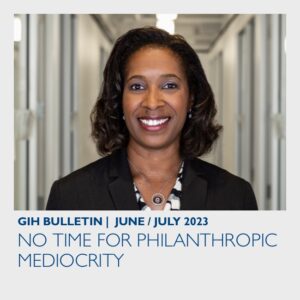Cara V. James, PhD, President and CEO, Grantmakers In Health
More than a month after the 2023 Grantmakers In Health Annual Conference on Health Philanthropy, Advancing Philanthropy’s Commitment to the Long Game, I find myself reflecting on numerous aspects from presentations to conversations. Two quotes in particular have stayed with me, and apparently others, as I have heard one of them referenced at meetings I have attended since our conference.
The first is from Gregory Jackson’s acceptance speech for the Andy Hyman Award for Advocacy. During his remarks, he shared an anecdote from his childhood that animates his work as Executive Director of the Community Justice Action Fund (CJAF), an organization working to build power with and for communities of color to end gun violence. Greg recalled how as a child, his parents would come into his room every morning and rouse him with the same words: “Wake up, we’ve got a lot of work to do.”
This resonated with me when thinking about the challenges we are facing. We talked about some of them at the conference, including gun violence, which is now the leading cause of death for children under the age of 19; access to reproductive health care; rebuilding trust with communities harmed by the past actions of those in power; mental and behavioral health; rebuilding public health; and achieving health equity. It also resonated because these may be difficult issues to address, but they are not insurmountable. Through the site visits, breakout sessions, and other presentations, we saw many examples of philanthropy and community doing the hard work needed to achieve better outcomes. Work that we know will take time and require long-term support to truly have the desired effect.
Greg knows firsthand how difficult that kind of long-term support can be to maintain. He told us about how he founded CJAF in 2016 after being a victim of gun violence, being treated with skepticism by law enforcement. We know Greg is not alone. On a recent visit to Jefferson County Public Health Department in Oregon, we were shown a diagram of the 14 different sources of funding being used to support maternal, infant, and early childhood home visits and the staff needed to run the program. And when discussing her work reporting on the implications of the Dobbs decision, Sarah Varney questioned whether she would still be doing the work in 10 years. Without organizations such as CJAF, local public health departments, CTUL and Tending the Soil, or the myriad others around the country working to improve the health and well-being of their communities, we in philanthropy cannot achieve our goals.
It’s not enough to acknowledge the need for a long game approach to philanthropy, we also have an imperative for us to do the hard work of supporting, shoring up, and strengthening grantees so that they can be there for their communities far into the future. It means that when we invest in people working to improve health, we must stay with them long enough for our support to engender lasting trust and lasting change.
And that support shouldn’t just be limited to an organization’s programmatic work. There is also the need for general operating support to invest in an organizations’ administrative capacity, such as information technology, human resources, finance, and communications. As Meera Chary, from the Bridgespan Group, said in our closing plenary, “We need to think carefully about how to invest in ensuring that these organizations can get these functions done, without necessarily presuming that they have what they need to build functions internally.” Kathy Brady, COO of Catchafire, noted the top request they receive from nonprofits is for website support, followed closely by help with organizational strategy. These functions are key to organizational success but are often not included in philanthropic grants.
The second quote that has stayed with me came from our board chair, Laura Gerald. During the opening plenary, “Harms and Healing: Grappling with Philanthropy’s Past,” she noted that “This is no time for philanthropic mediocrity.” Since the conference, I have heard others reference Laura’s statement. As I think about the problems we are trying to solve and the goals we are trying to achieve, doing the same thing the same way, or not doing something because it stretches us beyond our comfort zone will not lead us to achieve our goals.
To achieve our goals, we need to do things differently, invest in true community engagement and capacity, be innovative in our efforts, take risks, and use our voice and resources to change the systems and structures contributing to poor outcomes for the communities we care about. To achieve our goals, we also need to do a better job of working together. Too often we work in silos. Today’s challenges cannot be solved by one foundation, nor by philanthropy alone. They require collective action.
One example of collective action comes from last year’s Birth Equity Funders’ Summit in Atlanta. That meeting, supported by bi3, Community Health Acceleration Partnership, Grantmakers In Health, Funders for Birth Justice and Equity (formerly Midwifery Funders Group), Ms. Foundation for Women, Pritzker Children’s Initiative, and the W.K. Kellogg Foundation, in partnership with the Mom and Baby Action Network, resulted in a joint report capturing the summit’s themes and practical recommendations. There are others, but we need to generate many more.
We have a lot of work to do, and this is no time for philanthropic mediocrity. Together, we can continue to advance our commitment to the long game and develop meaningful practical strategies for furthering our ultimate mission of achieving better health for all through better philanthropy.

